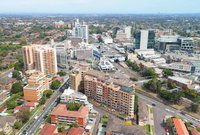Stage 3 Tax Cuts: Will It Allow Greater Access to the Property Market?
From the Desk of the Chief Economist
As the Financial Year 2023-2024 comes to an end, there is anticipation for Stage 3 tax cuts to come into effect – as it is promised to assist with cost-of-living.
Higher mortgage repayments and property prices climbing to greater heights has made home ownership a greater challenge. The question is: to what extent will stage 3 tax-cuts assist? Will it allow greater access to property markets?
Home Loan Affordability
Housing affordability has improved, albeit slightly, for the first time since 2021. Between December quarter 2023 and March quarter 2024 the proportion of family income needed to meet loan requirements declined from 47.7% to 46.7%.
Table 1. Proportion of family income needed to meet loan repayments (source: Real Estate Institute of Australia, Housing Affordability Report March quarter 2024)
Interestingly New South Wales saw the largest improvement in home loan affordability, though still holding the title for the most expensive state to live in. Dubbed the “more affordable place to live” Queensland and South Australia are among states that did not see an improvement; neither did Western Australia and the Northern Territory.
Stage 3 Tax Cuts
When the government released its Federal Budget 2024, stage 3 tax cut revisions was the main cost of living measure.
The Stage 3 tax cuts tax bracket, to come into effect on 1st July 2024, are as follows:
- Earn up to $18,200 – pay no tax
- Pay a 16% tax rate on each dollar earned between $18,201 - $45,000
- Pay a 30% tax rate on each dollar earned between $45,001 - $135,000
- Pay a 37% tax rate on each dollar earned between $135,001 - $190,000
- Pay a 45% tax rate on each dollar earned above $190,000
The stage 3 tax cuts will impact approximately 13.6million Australians and is designed to improve a person’s disposable income. For example, a person with a taxable income of $70,000 will take home $37,128.85 in FY2024-2025, a saving of $1,429 when compared to the $35,699.88 disposable income in FY2023-2024.
Having a higher disposable income provide households with many choices. From a property perspective, this translates into mortgage repayments or borrowing capacity. For those who are already home-owners and are paying a mortgage, the extra funds can be channelled into either extra repayments or a deposit into the mortgage offset account. For those about to take the plunge into home-ownership, it can translate to higher borrowing power.
A person earning (and thus a taxable income of) $120,000 has a borrowing power of $615,135.51 in FY 2023-2024. With stage 3 tax cuts, this increases to $642,197.44 in FY2024-2025. This is a significant increase of $27,061.93; or 4.4%. Those earning top dollar, of $140,000 and above, will still see the largest benefit, with their maximum borrowing power increasing by at least 5.36%.
Table 2. Stage 3 tax cuts impact on disposable income and borrowing power (source: Aussie Home Loans Stage 3 tax cuts media release, 19th June 2024)
Assuming the maximum borrowing represents 80% of the purchase price, based on a standard minimum 20% deposit (to avoid lenders mortgage insurance); this brings up the purchase price from $768,919 to $$802,747.
Note: this calculation does not include stamp duty, legal fees, grant and scheme incentives accessible to the buyer, and other associated costs / incentives.
Not surprisingly, the amount saved in taxes increases as one’s taxable income bracket climbs higher, resulting in a bigger difference in the maximum borrowing capacity between FY 2023-2024 and FY2024-2025.
Access into Australia’s Property Market
The Stage 3 tax cuts do put a prospective buyer in a more advantageous position, especially the price range that the person can now consider. That said, with house prices climbing higher than before, how does this translate in real terms? Is there greater access to the property market?
To work this out, we looked at house and unit sales for 2024 in all the Greater areas – i.e Greater Sydney, Greater Brisbane, Greater Melbourne; etc. We then compared this data to the purchase price as set out in Table 2, to work out the percentage of sales that is accessible to a particular taxable income bracket.
Table 3. Purchasing power under stage 3 tax cuts vs access to market (source: prepared by PRD Research, raw data through APM Pricefinder)
Table 2 suggest there is an increase in access to property markets, in all Greater areas. That said, the percentage change between the two financial years is not as high as expected. Further, it is quite limited to those earning a higher income.
For example, a person earning $90,000 will have access to 5.2% of houses in Greater Sydney Pre-Stage 3 tax cuts. Come 1st July 2024, the person will have 6.4% access. In comparison, a person earning $140,000 will see their access increase from 30.5% to 37.3% in the Greater Sydney house market.
We can see there is greater affordability in units, creating more opportunities for buyers. Greater Brisbane residents earning $80,000 can currently access 4.1% of houses, which will increase to 5.0% after Stage 3 tax-cuts. However, if they choose units, the Stage 3 tax-cuts allow for greater access, from 29.6% to 34.3%.
This research also suggests potential options for Australians. Residents of Greater Melbourne earning $120,000 currently can access 46.0% of houses, which will go up to 50.8% thanks to Stage 3 tax-cuts. Should that person choose to move to Greater Adelaide, after Stage 3 tax-cuts, they will have access to 56.6% of houses and 81.8% of units. Thus, improving their chances at home ownership.
Moving Forward
The Stage 3 tax cuts do impact a person’s maximum borrowing power, and thus the property purchase price that a person can access. On paper, the calculation is quite impressive – for example a person earning $120,000 can now consider a property listed in the early $800,000s, as opposed to mid-$700,000s. This widens the buyer’s prospects, essential in the current housing-supply shortage.
From a property perspective, will the Stage 3 tax cuts make a difference? Yes and no. It will not make a significant difference, as the percentage increase in access to market is somewhat small, between 5-7%, and will mostly be felt by those earning a higher income (i.e $120,000 and more). However, it does make some difference, especially regarding a home buyer’s hopes and positive sentiment. Combined with a stable interest rate, currently at 4.35%, and the outlook for stability (both in employment / wage growth and cash rate); the stage 3 tax cuts might just be what is needed to turn a cautious buyer into a signed contract.
PRD is an acknowledged industry real estate leader. We've been in the business of selling and managing properties since 1976 and have a strong network of franchise offices Australia-wide.
For further information, or to discuss any aspects of this analysis paper, please contact PRD Chief Economist, Dr Diaswati Mardiasmo at: research@prd.com.au.





